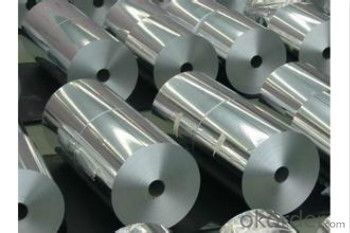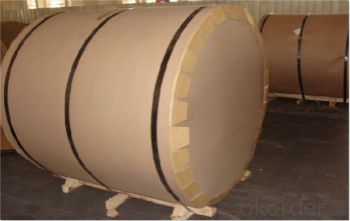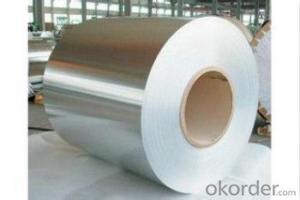Mill Finished Aluminium Coil AA1050 Temper H14
- Loading Port:
- Shanghai
- Payment Terms:
- TT OR LC
- Min Order Qty:
- 3 m.t.
- Supply Capability:
- 4000 m.t./month
OKorder Service Pledge
OKorder Financial Service
You Might Also Like
Item specifice
1. Aluminum Coil Description:
Aluminum coil, is a rolled product, produced in a coiled form of continuous strip, and having an ID (Inner diameter) and OD (Outer diameter).Common alloy coil are used for a wide variety of applications, alloy 1050, 1060, 3003, 3105, 3005, 5052, 5754, 5083, 6061, 8011, 8021, and so on, in thickness from 0.0065-7mm, in width from 300- 2200mm.
2.Main Features of the Aluminum Coil:
• Great ductility
• Heat conductivity
• Anti-corrosion
• Moisture resistanve
3.Aluminum Coil Images


4.Aluminum Coil Specification
Aluminum Coil/Sheet | |
Main Specification | |
Alloy | AA1xxx (AA1050, AA1060, AA1070, AA1100 etc.) |
AA3xxx (AA3003, AA3004, AA3005, AA3105 etc.) | |
AA5xxx, AA6XXX (AA5052,AA5083, AA5754, AA6061, AA6062 etc.) | |
AA8xxx(AA8011, AA8006, AA8079 etc.) | |
Temper | H14,H16, H18, H22, H24, H26, H32,O/F |
Thickmess | ≥0.2mm |
Width | 30mm-2100mm |
Standard | GB/T 3880-2006 |
Special specification is available on customer's requirement | |
5.FAQ
We have organized several common questions for our clients,may help you sincerely:
(1) How to guarantee the quality of the products?
We have established the international advanced quality management system, every link from raw material to final product. we have strict quality test; we resolutely put an end to unqualified products flowing into the market. At the same time, we will provide necessary follow-up service assurance.
(2) MOQ?
For trail order, we accept 5 MT.
(3) Payment term?
30% deposit, balance against the BL copy; 100% L/C at sight
(4) What is the delivery time?
Depends on actual order, around 30 to 35 days
- Q:Can aluminum coils be used in the production of electrical transformers?
- Yes, aluminum coils can be used in the production of electrical transformers. Aluminum coils offer several advantages such as being lighter in weight, having better thermal conductivity, and being more cost-effective compared to traditional copper coils.
- Q:could you please help me find information of the element aluminum??? all the information i can get will be great... thanks very mucho.... who discovered? where can i find pictures of it?
- Aluminum is from team 3 and there for has 3 electrons in its outer shell and desires 5 to fill it. it rather is going to react with any factors from team 5 that want aluminum's 3 electrons.
- Q:How are aluminum coils cleaned and maintained?
- Aluminum coils are typically cleaned and maintained by following a few key steps. Firstly, any loose debris or dirt should be removed using a soft brush or vacuum cleaner. Then, a mild detergent solution or a specialized coil cleaner can be applied to the coils, followed by gentle scrubbing with a soft brush to remove any stubborn dirt or grime. It is important to rinse off the cleaning solution thoroughly using a hose or pressure washer, ensuring no residue is left behind. Regular maintenance includes checking for any signs of damage or corrosion, and if required, applying a protective coating or lubricant to prevent future issues.
- Q:How do aluminum coils contribute to improved indoor comfort?
- Aluminum coils contribute to improved indoor comfort by efficiently transferring heat and cooling, allowing air conditioning systems to effectively regulate the temperature and humidity levels in a building. Their high thermal conductivity and durability enable them to rapidly cool or heat the air, maintaining a comfortable and consistent indoor environment. Additionally, their corrosion resistance properties ensure longevity and optimal performance of the HVAC system, ultimately enhancing overall comfort for occupants.
- Q:What is the average lifespan of aluminum coils?
- The average lifespan of aluminum coils can vary depending on various factors such as usage, maintenance, and environmental conditions. However, with proper care and maintenance, aluminum coils can typically last for 15 to 20 years or more.
- Q:What are the different coil lengths available for aluminum coils?
- The different coil lengths available for aluminum coils can vary depending on the specific manufacturer and application. However, common coil lengths for aluminum coils range from 50 feet to 1000 feet or more.
- Q:Can aluminum coils be used in the production of transportation vehicles?
- Indeed, the utilization of aluminum coils is feasible in the manufacturing process of transportation vehicles. Due to its lightweight nature and resistance to corrosion, aluminum has garnered significant favor within the automotive sector. The superior strength-to-weight ratio it possesses aids in enhancing fuel efficiency, decreasing emissions, and elevating the overall performance of vehicles. The versatility of aluminum coils allows for their application in the production of diverse components including body panels, frames, chassis, and suspension parts. Furthermore, the environmentally conscious attribute of aluminum lies in its recyclability, thereby bolstering the sustainability of the transportation industry.
- Q:How are aluminum coils different from steel coils?
- There are several aspects in which aluminum coils and steel coils differ. To begin with, aluminum is a lighter metal than steel, resulting in significantly lighter aluminum coils compared to their steel counterparts. As a result, aluminum coils are easier to handle and transport, reducing the overall weight of the final product. Secondly, aluminum possesses higher corrosion resistance in comparison to steel. Steel coils tend to rust and corrode over time, especially when exposed to moisture or harsh weather conditions. Conversely, aluminum coils have a natural oxide layer that acts as a protective barrier against corrosion. This characteristic makes them more durable and long-lasting. Moreover, aluminum exhibits higher thermal conductivity than steel. Consequently, aluminum coils excel in efficiently transferring heat, rendering them ideal for applications that necessitate excellent heat dissipation. Steel, being a poor heat conductor, is less effective in dissipating heat and may retain heat for longer durations. Another notable distinction lies in the aesthetic appeal. Aluminum coils possess a natural silver-gray color, which imparts a sleek and modern appearance. On the other hand, steel coils typically undergo coating or painting to enhance their appearance and safeguard against corrosion. Lastly, the cost factor plays a role in distinguishing aluminum and steel coils. Generally, aluminum is more expensive than steel, primarily due to the higher production costs associated with aluminum extraction and processing. Nonetheless, the long-term advantages of utilizing aluminum coils, such as lower maintenance and replacement costs due to their corrosion resistance, can offset the initial higher investment. In summary, aluminum coils differ from steel coils in terms of weight, corrosion resistance, thermal conductivity, aesthetics, and cost. These divergences make aluminum coils a popular choice in various industries where factors like lightness, durability, heat dissipation, and corrosion resistance hold pivotal importance.
- Q:I am so confused right know. I want to cook something using an aluminium foil. Is the reflective side supposed to be inside or outside?
- I always place my food on the dull side... but check out Reynolds FAQs Frequently Asked Questions Which side of Reynolds Wrap? Aluminum Foil should I use, the shiny or the dull side? Actually, it makes no difference which side of the aluminum foil you use—both sides do the same fine job of cooking, freezing and storing food. The difference in appearance between dull and shiny is due to the foil manufacturing process. In the final rolling step, two layers of foil are passed through the rolling mill at the same time. The side coming in contact with the mill's highly polished steel rollers becomes shiny. The other side, not coming in contact with the heavy rollers, comes out with a dull or matte finish. The exception is when using Reynolds Wrap? Release? Non-Stick Aluminum Foil. The non-stick coating is applied during manufacturing to the dull side of the foil. Always place the non-stick (dull) side toward the food.
- Q:How do you store and transport aluminum coils?
- Aluminum coils are typically stored and transported using a few different methods to ensure their safety and prevent damage. When it comes to storage, it is essential to keep the coils in a dry, clean, and well-ventilated area to avoid any moisture-related issues or corrosion. Ideally, the storage area should have a controlled temperature to prevent any extreme fluctuations that could affect the quality of the aluminum. To protect the coils from physical damage, they should be stored horizontally or vertically on a stable and level surface. It is crucial to avoid stacking them too high to prevent any potential collapse and ensure easy access for inspection or transportation purposes. Additionally, placing them on wooden pallets or racks with proper spacing between each coil can provide extra stability and protection. When it comes to transporting aluminum coils, there are several options available depending on the quantity, distance, and mode of transportation. For short distances or smaller quantities, hand trucks or forklifts can be used to move the coils onto a flatbed truck or a van. It is important to secure the coils properly using straps or bands to prevent any movement during transit. For larger quantities or longer distances, the coils can be transported using specialized coil carriers. These carriers are designed to securely hold multiple coils in an organized manner, limiting any potential damage caused by vibration or shifting during transportation. They are typically equipped with side rails and restraining bars to secure the coils in place. Regardless of the method used for transportation, it is crucial to handle the aluminum coils with care and ensure they are adequately protected. Regular inspections should be conducted before, during, and after transportation to identify any signs of damage or issues that could compromise the integrity of the coils. By following these guidelines, the storage and transportation of aluminum coils can be done efficiently and safely.
1. Manufacturer Overview |
|
|---|---|
| Location | |
| Year Established | |
| Annual Output Value | |
| Main Markets | |
| Company Certifications | |
2. Manufacturer Certificates |
|
|---|---|
| a) Certification Name | |
| Range | |
| Reference | |
| Validity Period | |
3. Manufacturer Capability |
|
|---|---|
| a)Trade Capacity | |
| Nearest Port | |
| Export Percentage | |
| No.of Employees in Trade Department | |
| Language Spoken: | |
| b)Factory Information | |
| Factory Size: | |
| No. of Production Lines | |
| Contract Manufacturing | |
| Product Price Range | |
Send your message to us
Mill Finished Aluminium Coil AA1050 Temper H14
- Loading Port:
- Shanghai
- Payment Terms:
- TT OR LC
- Min Order Qty:
- 3 m.t.
- Supply Capability:
- 4000 m.t./month
OKorder Service Pledge
OKorder Financial Service
Similar products
New products
Hot products
Related keywords





























